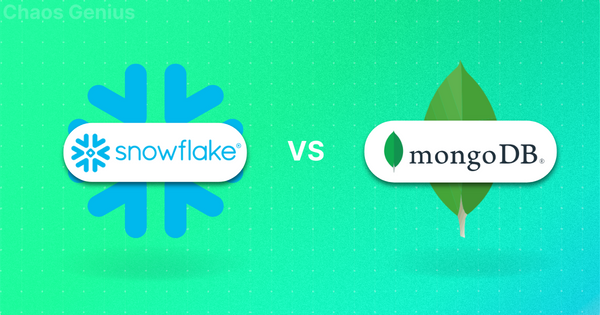Snowflake and MongoDB are two of the most popular database platforms today, but they differ greatly in their architecture, use cases, and capabilities. So, which platform comes out on top? Snowflake has established itself as a best-in-class cloud data warehouse, providing instant elasticity and separation of storage and compute. It uses SQL and a relational model. On the other hand, MongoDB is a document-oriented operational database that utilizes a NoSQL, JSON-like document model.
As per DB-Engines ranking, Snowflake currently ranks at 6th, whereas MongoDB ranks 5th among the most popular database management systems as of January 2025. Both of ‘em have massive and devoted user bases, ranging from startups to enterprises, across various industries and domains. But what makes them different and unique?
In this article, we will compare Snowflake vs MongoDB (❄️ vs 🍃) across 9 different key criteria—architecture, performance, scalability, integration/ecosystem, security, machine learning capabilities, programming language support, pricing—and more!! We'll highlight the unique capabilities and features of each platform and outline the core pros and cons to consider.
Let's dive right in and see how these two titans stack up!!
Snowflake vs MongoDB—Comparing the DB Titans
Before we dive into the details of each titan, let’s take a high-level look at the key differences between Snowflake and MongoDB. The following illustration compares the two titans on various aspects, including core architecture, data model, scalability, performance, security, governance, Data Science & ML support, ecosystem, and integration, etc.
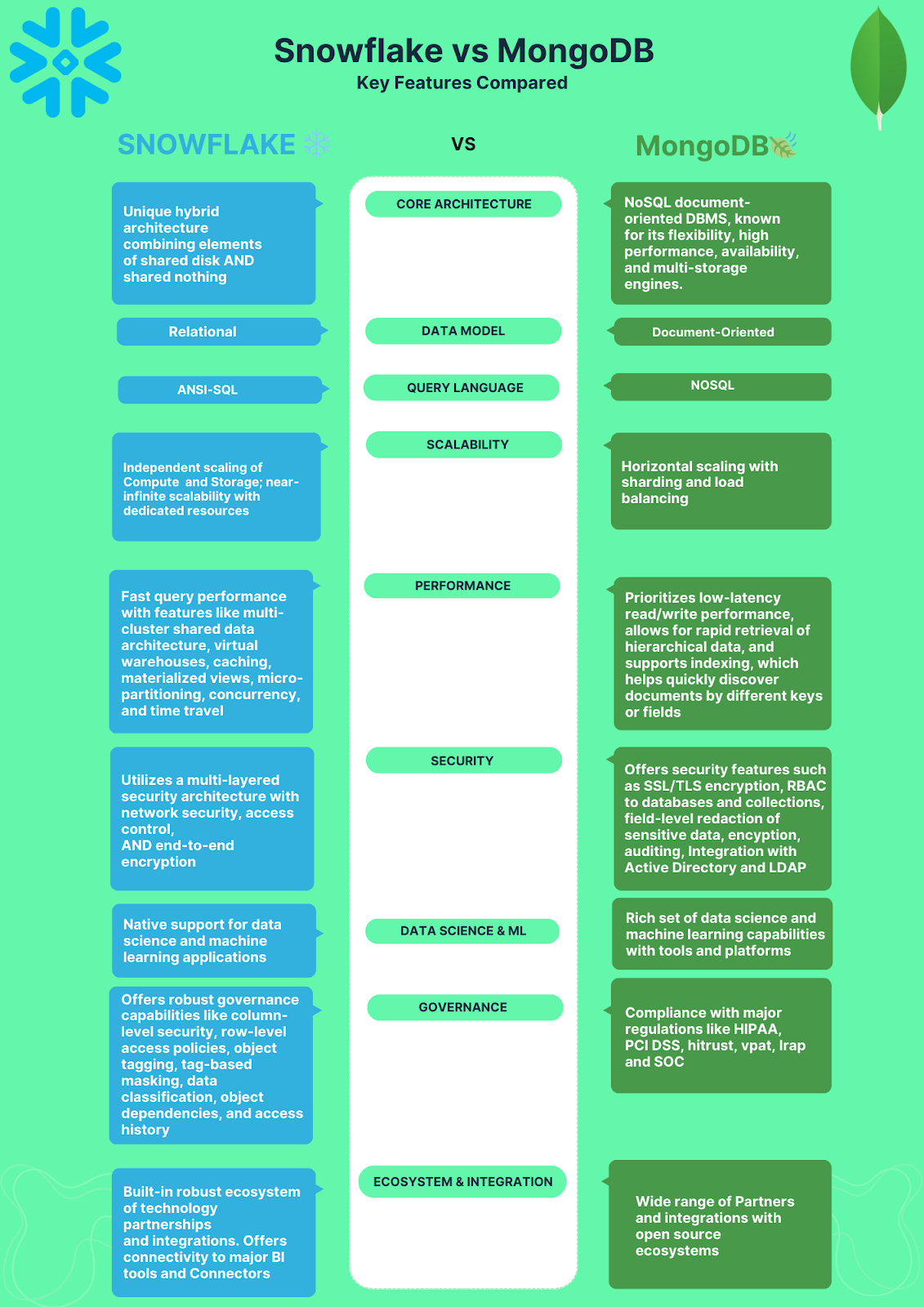
What is MongoDB?
MongoDB is a popular open-source (Source available) document-oriented database that uses NoSQL to store and manipulate flexible and dynamic data. Unlike relational DB’s that use tables and rows to store data, MongoDB uses collections and documents to store data. A document is a JSON-like object that can have any number of fields and values, and a collection is a group of documents that share a common schema or structure. MongoDB's story began in 2007 with three visionaries—Dwight Merriman, Eliot Horowitz, and Kevin P. Ryan—-who left their mark at DoubleClick. They wanted to create a database that could handle the large and complex data sets that were generated by web applications. But that wasn't all. They wanted a developer's dream—a DB that was both user-friendly and scalable, growing alongside its ever-expanding needs. And thus, MongoDB was born!!

Some of the key features of MongoDB are:
- Document data model: MongoDB stores data as JSON-like documents, which can have any number of fields and values of different types. Documents are grouped into collections (equivalent to tables in relational DBs). Documents can also have embedded sub-documents and arrays, which allow for complex and hierarchical data structures.
- Query language: MongoDB provides a powerful and expressive query language that supports CRUD (create, read, update, delete) operations, as well as aggregation, text search, geospatial queries, graph traversal, and more.
- Indexing: MongoDB supports various types of indexes, such as single-field, compound, multi-key, text, geospatial, hashed, and wildcard indexes, to optimize query performance and support different types of queries. Indexes can be created, modified, or dropped at any time, without affecting the availability of the database.
- Replication: MongoDB supports replication, which is the process of synchronizing data across multiple servers. Replication provides data redundancy, fault tolerance, and high availability.
- Sharding: MongoDB supports sharding, which is the process of distributing data across multiple servers or clusters. Sharding enables horizontal scaling, which means adding more servers to handle larger data sets and higher throughput. MongoDB uses a sharded cluster, which consists of shards, mongos, and config servers. Shards are replica sets that store a subset of the data, mongos are routers that direct queries to the appropriate shards, and config servers store the metadata of the cluster.
- Cloud services: MongoDB offers various cloud services, such as MongoDB Atlas, MongoDB Realm, and MongoDB Charts, to simplify the deployment, management, and visualization of MongoDB applications.
MongoDB is well-suited for highly scalable web and mobile applications. It is also popular for real-time analytics use cases. Major companies like eBay, Cisco, 7-Eleven, MetLife, Glassdoor, EA—and many others use MongoDB for their operational databases.
What is Snowflake?
Snowflake is a cloud-based data warehouse designed for the cloud. It utilizes a unique architecture that separates compute, storage, and cloud services layers to enable independent scaling and optimization.

Some key architectural features and capabilities of Snowflake are:
Here are some of the key features of Snowflake:
- Multi-cluster shared data architecture: Snowflake uses a shared data architecture where multiple virtual warehouses (compute clusters) can access common storage layers, allowing for seamless scaling of compute without moving data.
- Separation of storage and compute: Snowflake decouples storage from compute, allowing independent scaling of each. Users can add or remove virtual warehouses without impacting underlying data.
- Native support for semi-structured and structured data: Snowflake can natively load and query both semi-structured data (JSON, Avro, Parquet, XML) and structured data, which provides flexibility in handling diverse data types and sources.
- ANSI SQL support: Snowflake uses standard SQL for querying data, providing familiarity for SQL users.
- Secure data sharing: Snowflake allows secure data sharing across organizations via its data exchange and governed access features. Data can be securely shared without copying or moving data.
- Near-zero maintenance: Snowflake is fully managed and requires little administration or tuning. Users don't have to manage infrastructure, upgrades, or optimizations.
- Elastic scaling: Snowflake can automatically scale up or down virtual warehouses to match workload demands, providing elasticity in compute power.
- Concurrency and ACID transactions: Snowflake delivers high concurrency while ensuring ACID-compliant transaction processing for data integrity.
- Time travel and fail-safe schema evolution: Users can query or restore previous versions of data via Snowflake's time travel capability. Schema changes are also versioned for safe rollbacks.
- Granular access control: Role-based access control, row- and column-level security, and data masking allow granular control over data access.
- Hybrid and multi-cloud: Snowflake operates across AWS, Azure, and Google Cloud platforms, providing flexibility and avoiding vendor lock-in.
- Snowflake Pricing: Snowflake uses a pay-for-usage model, resource optimization, and flexible payment options and supports integration with cost-monitoring platforms (like Chaos Genius) for cost management.
…and much more!!
Check out this article for an in-depth look at Snowflake's full capabilities.
Now, let's dive into the next section, where we will compare Snowflake vs MongoDB across 9 different features.
Top 9 Detailed Features Breakdown—Snowflake vs MongoDB
Snowflake vs MongoDB are two very different data titans designed for different use cases. Let's navigate through the details and dissect their key features:
1). Snowflake vs MongoDB—Architecture & Data Models Breakdown
One of the most important aspects to consider when choosing a database is the architecture and data model, as they determine how the data is stored, processed, and accessed. Snowflake and MongoDB have different architectures and data models.
Now, let's explore their architectural differences.
Snowflake Architecture—Snowflake vs MongoDB
Snowflake utilizes a unique hybrid cloud architecture that combines elements of shared disk and shared nothing architectures. In the storage layer, data resides in a central data repository that is accessible to all compute nodes, like a shared disk. But, the compute layer uses independent Virtual Warehouses that process queries in parallel, like a shared-nothing architecture.
The Snowflake architecture has three layers:
- Storage Layer: Optimizes data storage and access. Data loaded into Snowflake is converted into a compressed, columnar format that reduces storage costs and improves query speed. The data is also partitioned into micro-partitions, which are logical chunks of data that enable fine-grained pruning and caching. The storage layer is fully managed by Snowflake, meaning that users do not need to worry about data loading, replication, backup, or recovery.
- Compute Layer: Utilizes scalable Virtual Warehouses to execute queries in parallel. Virtual Warehouses are independent MPP (Massively Parallel Processing) compute clusters that are provisioned on-demand by Snowflake. Users can create, resize, suspend, or resume Virtual Warehouses as needed, and pay only for the compute resources they use. Each Virtual Warehouse consists of multiple compute nodes that can access the same data from the storage layer, but process different portions of a query in parallel. Compute layer is independent and is similar to a shared-nothing architecture. The independence of Virtual Warehouses ensures optimal performance and isolation for different workloads and users.
- Cloud Services Layer: Manages authentication, infrastructure, metadata, query optimization, access control—and other services that are essential for the functioning of Snowflake. This layer operates on compute instances provisioned and managed by Snowflake. Additionally, the cloud services layer maintains a central repository of metadata, including table definitions, schemas, statistics, and query history. This metadata optimization facilitates query execution and enables features such as time travel and zero-copy cloning. The cloud services layer also enforces security and governance policies, such as encryption, role-based access control, auditing, and more.
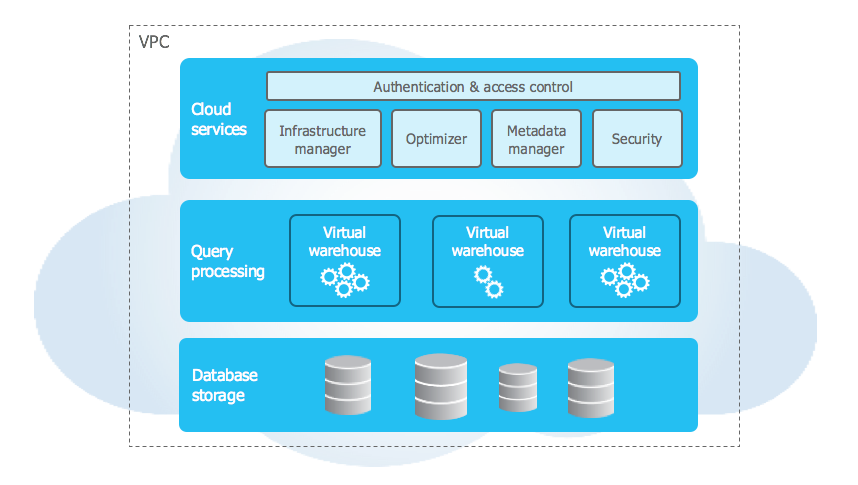
Check out this in-depth article if you want to learn more about the capabilities and architecture of Snowflake.
MongoDB Architecture—Snowflake vs MongoDB
As we have already covered, MongoDB is a NoSQL database that stores data in flexible, JSON-like documents. It does not require a predefined schema or a fixed table structure. Instead, MongoDB allows you to create collections of documents with different fields and data types. This flexibility makes MongoDB suitable for storing and querying diverse and complex data.
The architecture of MongoDB consists of three main components: databases, collections, and documents.
- Database: A database is a logical grouping of data that resides on a MongoDB server. A MongoDB server can host multiple databases, each with its own set of files on the file system. A database can contain one or more collections of documents.
- Collection: Think of collections as groups of documents. A collection is equivalent to a table in a relational database but without a fixed schema. A collection can have any number of documents, and each document can have different fields and data types.
- Document: These are the core units of data in MongoDB, represented as flexible JSON-like objects. Each document is essentially a collection of key-value pairs. But, documents are schema-less, meaning they can have different structures and data types within the same collection. This schema-less nature empowers developers to store complex and evolving data without schema rigidity.
On top of these core aspects, several other key features contribute to MongoDB's robust architecture:
- Storage Engines: MongoDB offers various storage engines like WiredTiger and In-Memory Storage Engine, optimizing performance for specific workloads.
- Query Language: MongoDB's query language (MQL) is powerful and expressive, allowing for complex data retrieval and manipulation.
- Aggregation Framework: The aggregation framework provides tools for advanced data processing and analysis directly within the database.
- Security: MongoDB incorporates security features like role-based access control and encryption for data protection.
2). Snowflake vs MongoDB—Performance Showdown
Snowflake and MongoDB both are high-performance platforms capable of managing large and complex workloads. Their performance varies based on factors such as query types, data models, indexing strategies, hardware configurations, network settings, and scaling options. This section compares and contrasts the performance of Snowflake vs MongoDB, exploring optimization possibilities for different scenarios.
Snowflake Performance—Snowflake vs MongoDB
Snowflake is built for massive scale and blazing-fast query performance. Its secret for performance lies in these unique characteristics:
- Separation of Storage and Compute: Snowflake separates data storage from compute resources. This allows you to scale storage independently of processing power, giving you the flexibility to handle massive datasets without compromising query speed.
- Massively Parallel Processing (MPP): Snowflake distributes queries across multiple nodes, leveraging the power of parallel processing to accelerate execution. This means complex queries on huge datasets can be completed in seconds or even milliseconds.
- Automatic Optimization: Snowflake constantly analyzes and adjusts query plans based on the data characteristics and the available resources. This removes the need for manual tuning, saving you time and effort.
- Automatic caching: Snowflake stores frequently accessed data in the memory of the virtual warehouse, reducing the need to read data from cloud storage. Snowflake’s caching is transparent and automatic and does not require any user intervention or tuning.
- Data compression and clustering: Snowflake compresses data using various algorithms, depending on the data type and size. Compression reduces the storage space and the network bandwidth required to transfer data, which improves performance and lowers the cost. Snowflake also allows users to define clustering keys that determine how data is ordered and organized in micro-partitions. Clustering improves the performance of queries that filter or join data based on the clustering keys, as Snowflake can skip irrelevant micro-partitions and access only the relevant ones.
- Data format and structure: Snowflake supports structured and semi-structured data types, such as JSON, and enables complex analytics and transformations on the fly. However, the performance of Snowflake may depend on the format and structure of the data. For example, Snowflake can handle JSON data natively, but it may perform better if the JSON data is flattened and stored in a relational format. Similarly, Snowflake can handle nested and repeated data, but it may perform better if the data is denormalized and stored in a single table.
- Virtual warehouse size and type: The size and type of the virtual warehouse determine the amount and quality of the compute resources available for query processing. Snowflake offers various sizes (from X-Small to 6X-Large) of virtual warehouses, each with different CPU, memory, and network bandwidth. The larger and more powerful the virtual warehouse, the faster the query execution and the higher the cost. Snowflake also lets you create multi-cluster warehouses that can scale out horizontally to handle concurrent and complex queries.
MongoDB Performance—Snowflake vs MongoDB
MongoDB shines in its agility and real-time capabilities. Its document-oriented NoSQL architecture offers several performance advantages:
- Schema-less Flexibility: MongoDB's schema-less nature allows you to store and query data without rigid schema constraints, making it ideal for rapidly evolving data sets and agile development environments.
- Horizontal Scalability: Sharding allows you to distribute data across multiple MongoDB servers, enabling seamless scaling to handle increasing data volumes and request loads, ensuring high availability and responsiveness even under heavy traffic.
- In-Memory Performance: MongoDB can leverage in-memory storage for frequently accessed data, significantly boosting query performance for specific workloads. Particularly beneficial for real-time applications and analytics.
To sum up, the performance champion in this showdown depends on your specific needs and priorities:
- For massive data warehouses and complex analytic workloads demanding high query speed and scalability, Snowflake is the best.
- For real-time applications, agile development environments, and flexible data structures, MongoDB is the best.
3). Snowflake vs MongoDB—Who Scales Better?
Snowflake and MongoDB are also highly scalable platforms for large and complex workloads. However, their scalability varies based on factors such as data type, query complexity, concurrency, and storage/compute requirements. In this section, we will compare the scalability of Snowflake vs MongoDB, exploring adjustments for different scenarios.
Snowflake Scalability—Snowflake vs MongoDB
At its core, Snowflake's architecture is designed for scalability. It uses a shared disk and shared nothing architecture with separate storage and compute resources. This decoupled design allows Snowflake to scale these resources independently as your data and query loads change.
In terms of storage, Snowflake seamlessly scales its data warehouse by adding additional storage nodes, accommodating the expansion of data volume without compromising query performance.
On the compute front, Snowflake provides virtual warehouses that can be scaled up or down independently of storage. This flexibility allows for precise adjustments in query capacity to align with the current workload.
But, Snowflake does have some constraints:
- Snowflake relies on the underlying cloud infrastructure (like AWS, GCP and Azure), which provides the physical resources and the network connectivity for Snowflake, meaning that any performance or reliability issues from the cloud provider, such as outages, latency, or throttling, will impact Snowflake as well.
- Snowflake offers fixed warehouse sizes, ranging from X-Small to 6X-Large. Each size has a predefined number of nodes and a predefined amount of CPU, memory, and network bandwidth. You can’t manually customize these parameters at a granular level, which can lead to over or under provisioning if your workloads don’t fit the predefined sizes.
- Users cannot dynamically resize nodes within a warehouse. They can only add more warehouses to scale out.
- Once large amounts of data are loaded into Snowflake, it can be challenging to move ‘em elsewhere due to egress fees and bandwidth limits, which effectively create lock-in.
- Snowflake limits clusters to a maximum of 128 nodes. This is the upper bound for the number of nodes that a virtual warehouse can have, regardless of the size, meaning that you can’t scale beyond this limit, even if you have more data or more queries.
MongoDB Scalability—Snowflake vs MongoDB
MongoDB excels in horizontal scalability, enabling you to expand by distributing data across multiple servers.
- Sharding: MongoDB allows users to scale out their database horizontally, by partitioning their data across multiple shards (or mongod instances) based on a shard key. Sharding allows users to distribute their data and workload across multiple machines, and increase their capacity and performance. MongoDB also supports automatic balancing, which ensures that the data is evenly distributed and consistent across the shards.
- Replication: MongoDB allows users to create replica sets, which consist of multiple copies of the same data on different mongod instances. Replication provides high availability and data redundancy, as well as read scalability and fault tolerance. MongoDB also supports automatic failover, which ensures that the database remains operational in case of a primary node failure or network partition.
- Deployment Flexibility: MongoDB can be deployed on-premises or in the cloud, offering flexibility to choose the infrastructure that best suits your needs. This helps you to scale with the specific resource constraints and deployment models of your environment.
- Flexible Data Modeling: MongoDB allows users to model their data in a flexible way, without having to adhere to a rigid schema or structure. MongoDB also supports dynamic schema changes, which makes it easy to modify the data model without affecting the existing data or queries, which enables MongoDB to handle diverse and evolving data, and adapt to changing business requirements.
But, MongoDB has some scalability limitations:
- Single document size(maximum BSON document size) is capped at 16MB, requiring larger data to be split across documents.
- Sharding requires manual configuration and placement of the shard key for optimal partitioning.
- Replica sets have a limited upper bound of 50 nodes.
- Complex multi-shard queries can be challenging to optimize and scale compared to SQL analytics.
So while MongoDB provides very high horizontal scalability, sharding, replication, and deployment flexibility, some data modeling and query constraints exist.
Both Snowflake and MongoDB deliver exceptional scalability, but their strengths cater to different scenarios:
- For managing petabyte-scale DW and handling massive, complex analytics workloads, Snowflake's elastic scalability provides unmatched flexibility and cost efficiency.
- For real-time applications, high availability requirements, and the need to scale horizontally on-premises or in the cloud, MongoDB's sharding and replication capabilities provide best and adaptable solution.
4). Snowflake vs MongoDB—Ecosystem & Integration
Snowflake and MongoDB both have extensive partnerships and integrations available.
Snowflake Ecosystem and Integration—Snowflake vs MongoDB
Snowflake has developed an extensive ecosystem of technology partners and integrations. It provides native connectivity to leading business intelligence tools like Tableau, Looker and Power BI for easy data visualization and dashboarding.
Snowflake also includes first-party and third-party connectors to ingest and analyze data from popular SaaS applications. On top of that, Snowflake has tight integrations with major cloud platforms—AWS, Azure, and GCP—enabling organizations to leverage their preferred infrastructure.
For custom integrations, Snowflake provides a REST API that can be used to build connections with diverse applications based on business needs.
To supplement its analytics capabilities, Snowflake partners with top data management and governance solutions. For example, it has partnered with Collibra for data cataloging and metadata management, Talend for ETL and data integration, and Alteryx for data blending and preparation.
The Snowflake Marketplace offers various partner applications, connectors, and accelerators that extend Snowflake's core functionalities. However, compared to open-source(source-available) options like MongoDB, the Snowflake ecosystem is relatively closed as a proprietary commercial product. But it provides deep integration with both tools and infrastructure.
MongoDB Ecosystem and Integration—Snowflake vs MongoDB
MongoDB has a vibrant and growing partner ecosystem that offers various integrations and solutions for users.
Cloud Partners
MongoDB can run on various cloud platforms, such as AWS, Azure, and GCP, and across different regions and zones. MongoDB also offers a database-as-a-service solution, called MongoDB Atlas, which handles the provisioning, management—and monitoring of MongoDB clusters on the cloud.

Drivers and Client Libraries
MongoDB provides officially supported drivers for all major programming languages and platforms. These drivers allow developers to connect their applications to MongoDB databases and perform CRUD operations.
Some of the most popular MongoDB drivers include:
- MongoDB Node.js Driver: Enables interacting with MongoDB from Node.js applications using asynchronous I/O.
- MongoDB Java Driver: Provides synchronous and asynchronous interaction with MongoDB from Java applications.
- MongoDB .NET/C# Driver: Allows .NET developers to work with MongoDB databases.
- PyMongo: The official Python driver for MongoDB.
—and more!
There are also hundreds of community-supported libraries available.
Tools and Integrations
MongoDB offers an extensive range of tools and integrations that make it easier for developers and administrators to work with MongoDB databases. These include:
- MongoDB Compass: GUI-based query interface and document explorer for MongoDB. Provides features like graphical view of query performance, visual query builder and more.
- MongoDB Charts: Built-in data visualization tool that provides intuitive charts and graphs for analyzing and visualizing MongoDB data.
- MongoDB BI Connector: Provides read-only SQL access to MongoDB databases from BI and data visualization tools like Tableau, Qlik and others.
- MongoDB Ops Manager: Automates MongoDB deployment, upgrades, backup and more. Available as a self-hosted or fully managed solution.
- MongoDB Atlas Data Lake: Query engine for Amazon S3 buckets that enables MongoDB querying against data in S3.
- MongoDB & HashiCorp Terraform: Infrastructure as Code tool that provides providers for deploying MongoDB on various platforms.
- MongoDB Enterprise Kubernetes Operator: Simplifies running MongoDB on Kubernetes for container orchestration.
There are also hundreds of integrations available from partners that allow syncing MongoDB with other DB, analytics and visualization tools, caching systems, message queues—and more. You can check the MongoDB Partner Ecosystem Catalog, which provides a directory of MongoDB partners offering compatible technologies and services for MongoDB implementations.
Community Support Resources
MongoDB has cultivated an active community of users, developers, admins and partners through community forums, events, courses—and more:
- MongoDB Community Forums: Active forums for asking questions and getting help from MongoDB experts and community members.
- MongoDB University: Free online courses for learning MongoDB design, operations, security, performance tuning and more.
- MongoDB Events: Global events including MongoDB World conference and local MongoDB Days workshops.
- MongoDB Blog: Regular educational blog posts and announcements from MongoDB experts.
- MongoDB Community: Get help from fellow MongoDB users on the community-run forums/channels.
- MongoDB Meetup Groups: Opportunities to connect with local MongoDB users at in-person Meetup events.
- MongoDB Developer Center: Resources for developers building apps on MongoDB.
5). Snowflake vs MongoDB—Security & Governance
Snowflake and MongoDB are reliable data platforms with distinct approaches to ensuring data security and governance. This section compares and contrasts their methods, examining how each platform secures and governs your data.
Snowflake Security & Governance—Snowflake vs MongoDB
Snowflake provides robust security capabilities to safeguard data and meet compliance requirements. Snowflake utilizes a multi-layered security architecture consisting of network security, access control, and End-to-End encryption.
Network security
Snowflake allows configuring network policies to restrict access to only authorized IP addresses or virtual private cloud (VPC) endpoints. Users can set up private connectivity options like AWS PrivateLink or Azure Private Link to establish private channels between Snowflake and other cloud resources.
Access Control
Snowflake has extensive access control mechanisms built on roles and privileges. Users can create roles aligned to specific job functions and assign privileges like ownership or read-write access accordingly. Granular access control is also possible through Object Access Control, Row Access Control via Secure Views and Column Access Control by masking columns. Multi-factor authentication and federated authentication via OAuth provide additional access security.
Encryption
Encryption is a core part of Snowflake's security posture. All data stored in Snowflake is encrypted at rest using AES-256 encryption by default. Snowflake supports both platform-managed and customer-managed encryption keys. For key management, Snowflake provides built-in key rotation and re-keying capabilities. Users can also enable client-side and column-level encryption for enhanced data protection.
Snowflake Governance
Snowflake offers robust governance capabilities through features like column-level security, row-level access policies, object tagging, tag-based masking, data classification, object dependencies, and access history. These built-in controls help secure sensitive data, track usage, simplify compliance, and provide visibility into user activities.
Check out this article to learn more in-depth about implementing strong data governance with Snowflake.
MongoDB Security & Governance—Snowflake vs MongoDB
MongoDB’s security capabilities are configurable and customizable, and are designed to provide various options and features to secure and govern your data. Some of the key security capabilities of MongoDB are:
Authentication and authorization
MongoDB supports various mechanisms to authenticate and authorize users and applications to access the database, such as SCRAM, x.509, LDAP proxy authentication, Kerberos, and OpenID Connect. MongoDB also provides role-based access control (RBAC) to manage the permissions and privileges of users and roles on the database, such as creating, reading, updating, and deleting data and objects.
Encryption and masking
MongoDB supports various methods to encrypt and mask data stored and transferred on the database, such as TLS/SSL, encryption at rest, and client-side field level encryption. MongoDB also supports customer-managed encryption keys, which allow users to control the encryption and decryption of their data. MongoDB also integrates with various third-party encryption and masking solutions, such as Baffle, Protegrity, and SecuPi.
Auditing and logging
MongoDB provides granular auditing and logging capabilities, which allow users to monitor and track the activities and events on the database, such as user login, data access, data manipulation, data replication and data sharding. MongoDB also provides various tools and utilities to query and analyze the audit and log data, such as the MongoDB Audit Log Filter, hatchet, MongoDB Log Analyzer, and MongoDB Compass.
Data governance and classification
MongoDB provides various features and tools to help users govern and classify their data on the database, such as schema validation, data quality rules, data lineage, and data catalog. These features and tools allow you to define, enforce, and document the structure, quality, and origin of their data, and identify sensitive, personal, or regulated data. MongoDB also integrates with various third-party data governance and catalog solutions, such as Atlan, BigID, and Immuta.
Data protection and compliance
MongoDB provides various features and mechanisms to protect and comply with the data regulations and standards, such as CSA STAR, VPAT, GDPR, IRAP, HITRUST, HIPAA, PCI DSS, SOC—and so much more. These features and mechanisms include data retention and deletion, data anonymization and pseudonymization, data breach notification and response, data subject rights and requests, data processing agreements and contracts, and data security certifications and attestations.
Check out this MongoDB Trust Center to learn more in-depth about MongoDB data security and governance features.
6). Snowflake vs MongoDB—Data Science & Machine Learning Magic
Finally, let’s Embrace the cutting-edge world of data science and machine learning as we compare Snowflake vs MongoDB. Both of Snowflake and MongoDB have equally powerful capabilities in this domain. Both of these platforms are really powerful in their own right. But we've gotta figure out which one comes out on top for machine learning applications.
Snowflake's Data Science & Machine Learning Capabilities—Snowflake vs MongoDB
As a cloud data warehouse, Snowflake is purpose-built for analytics workloads. It natively supports an array of features and optimizations that data scientists and analysts can leverage:
- Programming languages like JavaScript(Node.js), Python, .NET, Go and more can be used via user-defined functions (UDFs) to perform data transformation and statistical modeling right within Snowflake. No external ETL or platforms are required.
- Snowpark ML, Snowflake's developer framework, allows data engineers, scientists, and application developers to build and deploy machine learning models. With Snowpark ML, you can pre-process data and train, manage, and deploy ML models all within Snowflake.
- Built-in statistical functions in Snowflake SQL provide the basics like CORR, COVAR_SAMP, MEDIAN, etc that data scientists can leverage for exploratory analysis.
- Snowpark Container Services enables the effortless deployment, management, and scaling of containerized models. Fine-tune open-source LLMs securely using Snowflake-managed infrastructure with GPUs—all within Snowflake.
- Partnerships with data science platforms like DataRobot, Dataiku, and H20.ai allow leveraging MLOps and Automated ML capabilities pre-integrated with Snowflake’s data. This simplifies the model-building lifecycle.
MongoDB Data Science & Machine Learning Capabilities—Snowflake vs MongoDB
While not purpose-built for analytics workload, MongoDB provides extensive machine learning support through native integrations, partnerships, and its Atlas cloud:
- MongoDB Charts is a graphical data analysis and data visualization tool built into Atlas. It enables aggregations and exploratory analysis without coding using an intuitive GUI.
- MongoDB supports integrating Python, R, and other languages for data analysis via drivers. Popular ML libraries like NumPy, SciPy, Pandas, Scikit-Learn, PyTorch, and TensorFlow can be connected to MongoDB.
- The native aggregation pipeline allows performing complex data analysis and transformations efficiently within MongoDB using declarative JSON syntax without moving data externally.
- Atlas Data Lake supports storing raw data from MongoDB databases, S3, and other sources in one location for ML workflows.
- MongoDB has partnerships with loads of AI/DS/ML platforms to provide integrated ML tooling optimized for MongoDB data.
7). Snowflake vs MongoDB—Programming Language Support
Snowflake and MongoDB are both versatile data platforms that can support various programming languages and development platforms. In this section, we will compare and contrast the programming language support of Snowflake and MongoDB, and see how they can enable developers to build applications using their preferred languages and tools.
Snowflake Programming Language Support—Snowflake vs MongoDB
Snowflake supports developing applications using many popular programming languages and development platforms. Using native clients (connectors, drivers, etc.) provided by Snowflake, you can develop applications using any of the following programmatic interfaces:
- ANSI SQL: Snowflake supports the ANSI SQL standard, which is a common and widely used language for querying and manipulating relational data. Snowflake also extends the ANSI SQL syntax with some Snowflake-specific features and functions, such as data loading, data sharing, time travel, and clustering. You can use ANSI SQL to interact with Snowflake from various tools and applications, such as SnowSQL (the Snowflake command-line client), Snowflake web interface, and third-party SQL clients.
- User-Defined Functions (UDFs): Snowflake allows you to create and execute user-defined functions (UDFs) that extend the functionality of Snowflake and perform custom logic on your data. You can create UDFs using the following languages:
- JavaScript
- Python
- Java
- Scala
- SQL UDFs
MongoDB Programming Language Support—Snowflake vs MongoDB
MongoDB also supports various drivers and libraries for connecting to the database from different languages and frameworks, such as:
On top of the official drivers, MongoDB also has a strong community that has developed additional libraries and drivers to work with nearly every programming language that exists today.
8). Snowflake vs MongoDB—Indexing & Optimization Secrets
Snowflake and MongoDB are both efficient data platforms that can optimize query performance and data access. But, they use different approaches and techniques to achieve this goal. In this section, we will compare and contrast the indexing and optimization secrets of Snowflake vs MongoDB, and see how they can improve the speed and quality of queries.
Snowflake Indexing & Optimization Secrets—Snowflake vs MongoDB
Unlike traditional DBs, Snowflake does not use indexes to optimize queries. Instead, Snowflake leverages its cloud-native architecture and features like micro-partitioning, automatic clustering, and query optimization to deliver fast query performance.
Snowflake stores data in small micro-partitions, typically 50 MB to 500MB in size. Micro-partitions contain a subset of rows stored in a columnar format. This enables parallel processing and scanning only relevant data during queries.
Snowflake utilizes sophisticated query pruning techniques. Using statistics on micro-partitions and query predicates, Snowflake determines which micro-partitions can be eliminated from scanning based on the query filter conditions. This minimizes the amount of data required for processing.
For further optimization, Snowflake can automatically cluster data by grouping related rows into the same micro-partitions. A clustering key defines the column(s) to cluster data on. Clustering improves pruning efficiency as related rows exist in fewer partitions.
On top of all this, Snowflake continuously analyzes comprehensive query history and table statistics to adapt and optimize query execution plans over time. It determines the optimal approaches to process different query types and data shapes without manual tuning.
When you combine micro-partitions, intelligent optimization, clustering, and scale-out compute, Snowflake doesn't need traditional database indexes for most workloads!
Of course, Snowflake does have some tools like materialized views for tuning specific performance-intensive use cases. But in general, its architecture minimizes the need for indexes. The cloud-scale optimizations happen automatically "under the hood".
MongoDB Indexing & Optimization Secrets—Snowflake vs MongoDB
Now MongoDB comes from a very different background than Snowflake. It was built as a general operational database for powering real-time applications.
Given that mission, MongoDB needed to enable high performance inserts, updates, and lookups on dynamic data. And it did this by embracing indexes and tunability rather than fully automating everything under the hood.
You see, MongoDB stores data in flexible documents rather than rigid tables with predefined schemas. So to allow efficiently finding documents and fields, MongoDB offers extensive indexing capabilities tuned for document structure.
Developers can specify indexes on fields, nested attributes, or document structures they want to optimize query performance for. Indexes then allow rapid and efficient execution of queries in MongoDB. Without indexes, MongoDB must scan every document in a collection to return query results.
For instance, an e-commerce app may index order dates, product categories, customer IDs, and so on. This would speed up critical queries like looking up orders by date, or products by category, or a customer's order history.
MongoDB does also do some query optimization like caching frequently used indexes or results in memory. But most optimizations are centered around making indexes work optimally.
The key value of indexes in MongoDB is they put control in developers' hands. You can choose to optimize for read performance vs write speed based on your app's needs. Of course, this does require diligently profiling queries and tuning indexes for optimal efficiency.
9). Snowflake vs MongoDB—Billing & Pricing Models
Last but certainly not least, Snowflake and MongoDB differ significantly in their pricing models. In this section, we'll navigate the intricacies of "Snowflake vs MongoDB" pricing to help you make the most informed and budget-conscious decisions for your data platform investment.
Snowflake pricing Breakdown—Snowflake vs MongoDB
Snowflake uses a pay-per-second billing model based on actual compute usage, rather than fixed hourly or monthly fees. Users are charged by the second for the processing power used based on the size of virtual warehouses deployed. Snowflake separates storage charges from compute. Storage is charged based on average monthly storage usage after compression.
Snowflake offers four editions with different features and pricing:
Snowflake measures usage in "credits", where one credit equals one minute of compute usage on a small virtual warehouse. Credit costs vary by edition and cloud provider. Snowflake’s pricing reflects the actual usage patterns of users. Users only pay for the resources they use, without having to overprovision or underutilize capacity. The pay-per-second model and auto-suspending of warehouses help reduce unnecessary costs.
Check out this article to learn more in-depth about Snowflake pricing.
MongoDB Pricing Breakdown—Snowflake vs MongoDB
MongoDB offers various editions suited for different use cases with different pricing models.
The core MongoDB editions are:
- MongoDB Community Server: The free and open source edition available under SSPL license. It offers basic MongoDB features like sharding, replication, and ad-hoc queries. But usage is limited to non-commercial purposes.
- MongoDB Atlas: The fully managed cloud database as a service (DBaaS) offering. It provides automated provisioning, operations, scaling—and resiliency. Pricing is usage-based per hour.
- MongoDB Serverless: A serverless version of Atlas to provide greater cost efficiency. Pricing is pay-per-use based on a number of reads.
- MongoDB Enterprise: On-premises or private cloud version with advanced features for mission-critical deployments. Pricing is custom-based on infrastructure sizing.
Also, MongoDB offers companion products like MongoDB Charts, MongoDB Compass(Free to use), and MongoDB Ops Manager which may have separate pricing structures.
Note that MongoDB Community and Enterprise editions are self-managed and support multi-cloud deployment, following a different billing method from the MongoDB Atlas product. Despite offering limited features, the open-source version provides ample capabilities and support. The MongoDB Community Server is freely available under SSPL, allowing you to modify the source code; however, commercial use for SaaS products is restricted.
MongoDB Atlas Pricing Model
The cost of using MongoDB Atlas depends on how much you use it and what options you pick. Some of the things that affect your bill are:
- Which cloud service you use (AWS, Azure, or Google Cloud)
- How big and powerful your clusters are
- Cluster Region
- Data transfer cost
- What extra features do you need, like backups, faster storage, or more support
MongoDB Atlas is a service that lets you use MongoDB in the cloud without worrying about setting it up or managing it. You can store and query your data in a flexible and reliable way.
MongoDB Atlas Cluster Tier
You pay for the features you use based on the cluster tier you choose.
MongoDB Atlas lets you use MongoDB in the cloud with different levels of performance, storage, and cost. You can choose from different cluster tiers, from M0 to M700, depending on your needs and budget. All clusters use MongoDB 5.0, the latest version of the DB system.
- M0 cluster is free and great for testing out Atlas and building tiny projects.
- M2 and M5 are "shared" clusters, meaning the resources are shared with other customers. They give you a bit more storage and memory than M0, plus backups and API access. Good for basic apps with low traffic.
- M10 and M20 are entry-level "dedicated" clusters, so you get your own resources. They work for low-volume apps but can only do replica sets right now.
- M30 and up are more powerful dedicated clusters designed for big datasets and high-traffic loads. They give you full access to Atlas features and can do replica sets or sharded clusters.
- Some of the beefiest dedicated cluster tiers (M40, M50, M60, M80, M200, and M400) use speedy NVMe SSD storage. They are only available on AWS. You can’t pause these clusters when you don’t use them.
- Azure also has NVMe clusters (M60, M80, M200, M300, M400, and M600) clusters are also special clusters that use NVMe SSDs, but they are only available on Azure. They are similar to the AWS clusters. You can’t pause them either.
- But Google Cloud doesn't support NVMe with Atlas currently.
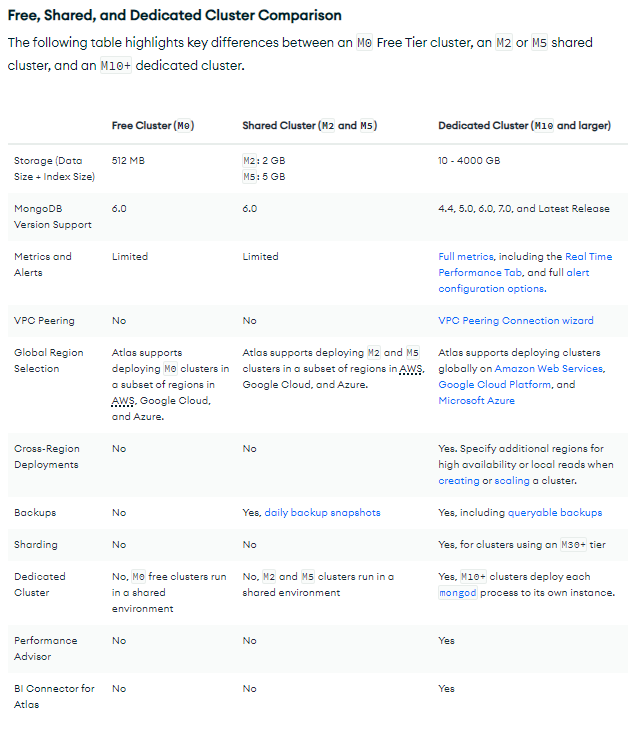
Atlas is offered across 4 pricing tiers—Free, Shared, Serverless and Dedicated. Let's look at each of ‘em:
- Free Tier: Includes M0, M2, and M5 clusters. You get up to 5GB storage, 512MB shared RAM, and a shared CPU. Has monitoring, security features, and other basics. Great for testing!
- Shared Tier: Builds on the Free Tier. Adds backups, more API access and such. Still shared resources though. Good for low-traffic apps.
- Dedicated Tier: Starts at around $57/month. Gets you dedicated resources that scale up to 96 vCPUs, 768GB RAM, and 4TB storage per shard. More features for production apps.
- Serverless Tier: Pay per million reads, about $0.1 each. Up to 1TB storage, scalable RAM/CPU, and backups. Auto-scales.
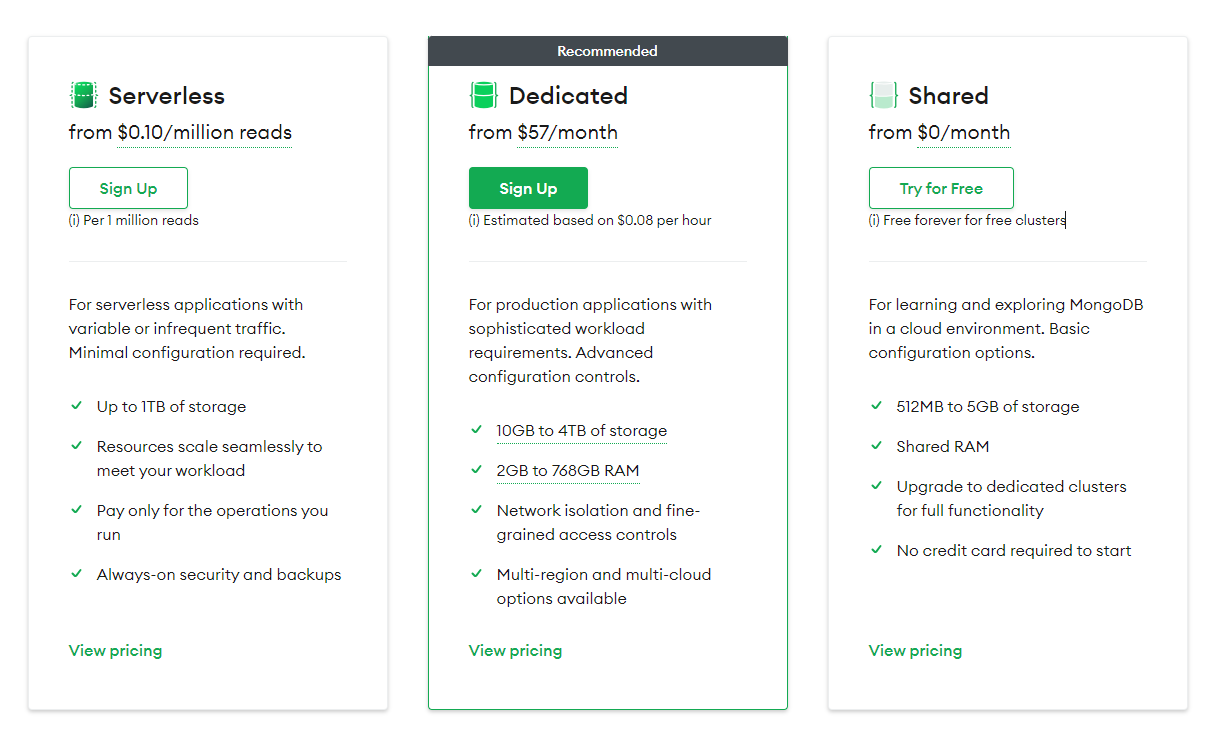
The cloud provider you use also affects pricing. Here's a quick rundown:
MongoDB Atlas pricing on AWS
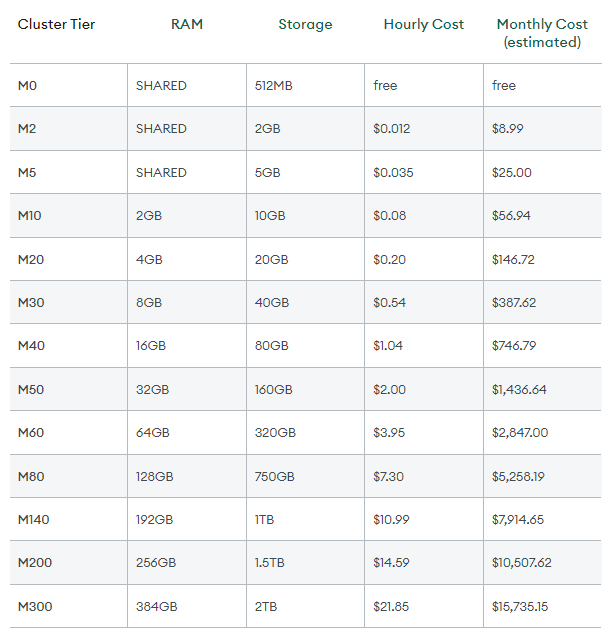
You can also use low-CPU instances with similar RAM and storage, like these:
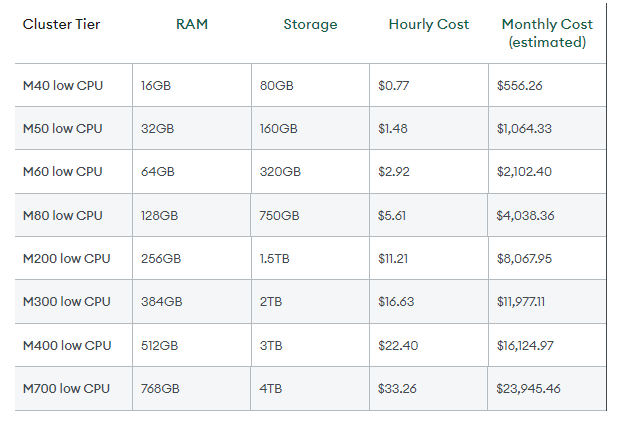
Other factors that affect MongoDB pricing on AWS are:
- Data transfers: You pay for the data you send and receive from your clusters. It costs $0.01 per GB for transfers within the same region, $0.02 per GB for transfers across regions, and $0.09 per GB for transfers to the internet.

- Backups: You pay for the backups you make of your data. It costs $0.14 per GB per month, based on the size of your data files on the disk.
MongoDB Atlas pricing on Azure
MongoDB Atlas uses pay-as-you-go pricing on Azure too. They have a free tier to get started.
After that, pricing begins at around $0.01 per "Consumption Unit".
The exact amount depends on:
- The size Azure instance you choose (number of vCPUs, RAM, etc)
- Which Azure region your cluster is in
- The availability zone within that region
- How heavily do you use the cluster
Here is a brief overview of each tier:
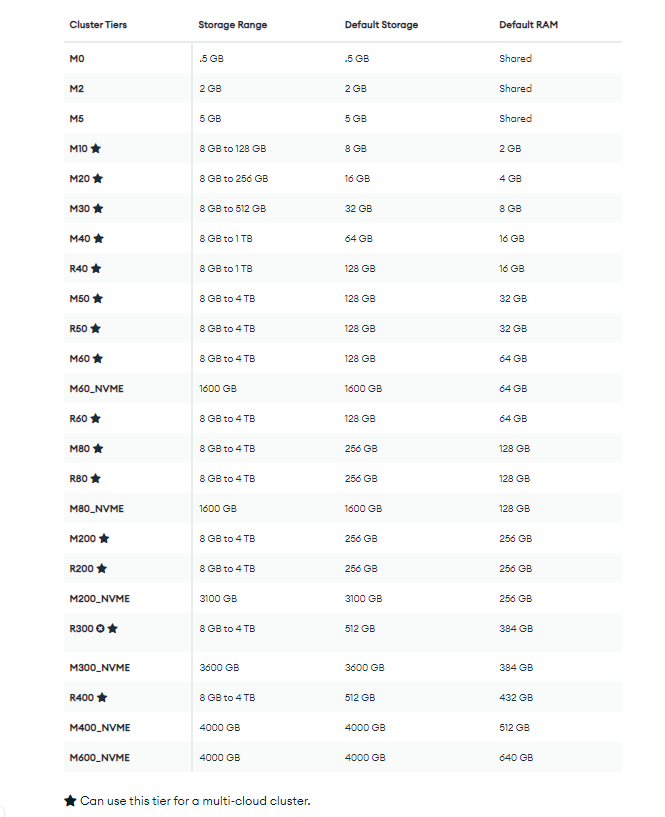
As on AWS, your app's usage, data transfers, and backups will also add to the costs.
But the key point is you can start small on Azure and scale up as needed, paying per Consumption Unit. The free tier lets you try it out.
MongoDB Atlas pricing on Google Cloud
MongoDB Atlas uses pay-as-you-go hourly billing on Google Cloud Platform (GCP). You get charged about $0.01 per "Consumption Unit".
Like with AWS and Azure, the exact price depends on:
- The GCP instance size and configuration you choose
- Which region and availability zone you use
- How heavily you use the cluster
- You can start with the free tier on GCP to try it out.
Here is a brief overview of each cluster tier:
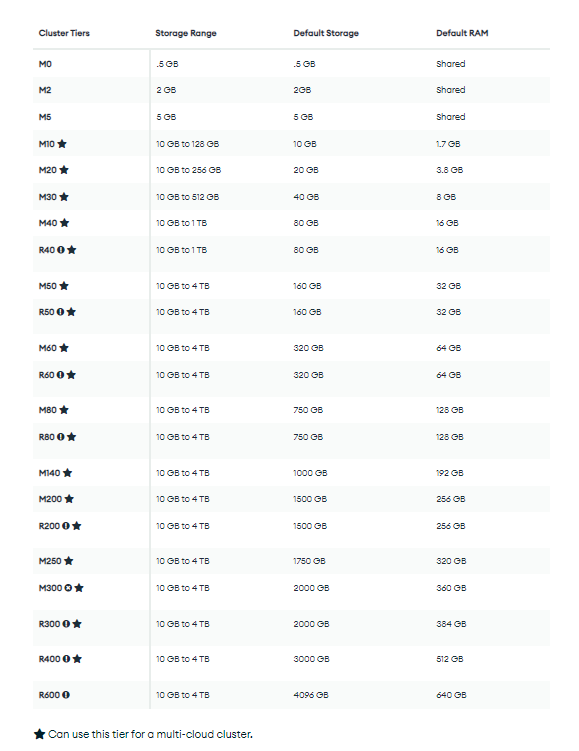
Snowflake vs MongoDB—Pros and Cons:
Snowflake pros and cons: To Choose or Not to Choose?
Here are the main Snowflake pros and cons:
Snowflake Pros:
- Elasticc Scalability — Snowflake scales storage and compute independently, allowing you to handle any workload without downtime or performance bottlenecks.
- Fast and Concurrent Processing — Snowflake offers blazing-fast query processing and the ability to run multiple concurrent workloads simultaneously. Built-in caching and micro-partitioning further enhance performance.
- Robust Security — Snowflake prioritizes data security with robust encryption, network policies, access controls, and regulatory compliance.
- High Availability and Recovery — Data is stored redundantly across multiple cloud providers and availability zones, ensuring high availability. Time Travel and Fail-safe features provide additional data recovery options.
- Cost Optimization — Pay only for the storage and compute you use per second. Auto-scaling and auto-suspend features further optimize costs, making Snowflake a cost-effective solution.
- Ease of Use — Snowflake utilizes standard SQL and boasts an intuitive UI, making it easy to set up and use even for non-technical users.
- Broad Ecosystem Integration — Snowflake offers extensive ecosystem support and native connectivity to many data sources, enabling seamless data integration.
Snowflake Cons:
- Potential Cost Concerns — Unoptimized cloud infrastructure can lead to high costs. Careful sizing and scaling are crucial for cost-effectiveness.
- Cluster Optimization Complexity — Configuring and optimizing clusters for different workloads can be complex, requiring technical expertise.
- Data Streaming Maturation — Snowflake's data streaming capabilities via Snowpipe and Stream are still evolving. Additional ETL tools may be needed for robust data pipelines.
- Limited Database-Level Tuning — Snowflake offers less granular control over database-level tuning and optimization compared to traditional on-premise solutions.
- Limited On-Premise Support — Snowflake's on-premise support is still new and limited, making it less suitable for hybrid cloud environments.
- Vendor Lock-in Concerns — While Snowflake claims multi-cloud capabilities, tight integration with major cloud vendors can lead to vendor lock-in.
MongoDB pros and cons: When and When Not to Utilize?
Here are the main MongoDB pros and cons:
MongoDB Pros:
- Extensive Language Support — Extensive programming language support through official and community drivers for Java, Python, Node.js, C#, and many more.
- High Performance and Scalability — MongoDB offers outstanding performance and horizontal scalability through its native sharding architecture, enabling it to handle massive datasets efficiently.
- Replication for Redundancy and Availability — Replication features ensure data redundancy and high availability, minimizing downtime and data loss.
- Flexible Document Model — MongoDB's flexible document model effortlessly represents hierarchical and polymorphic data structures, making it ideal for diverse data types.
- Rich Query Language and Aggregation — The native query language and aggregation framework empower users to perform ad-hoc queries without requiring SQL expertise.
- Powerful Indexing Capabilities — MongoDB provides robust indexing features to optimize query performance, significantly improving data retrieval speeds.
- Wide Integration Ecosystem — MongoDB boasts a wide range of integrations and partnerships, extending its capabilities and interoperability with other technologies.
- Native Analytic Features — Built-in analytic features and support for data science workflows enable data analysis and insights directly within the database.
MongoDB Cons:
- Data Duplication — Document model can potentially lead to data duplication across records and collections, requiring careful data modeling and management.
- Joins and Aggregation Limitations — MongoDB is not optimized for complex joins and aggregations across documents, potentially impacting performance for certain analytical workloads.
- Schemaless Design Challenges — While flexible, the schemaless design can make maintaining data integrity and governance more challenging, necessitating careful schema design and data validation.
- Open Source Tooling Expertise — Open-source tooling often requires greater in-house expertise compared to commercial alternatives, potentially increasing maintenance and support costs.
- Sharding Complexity — The sharding architecture can add complexity to administration and deployment, requiring specialized knowledge and skills.
- Indexing Expertise — Finding and maintaining optimal indexes for performance optimization requires significant expertise and ongoing maintenance.
- Not Ideal for Complex BI Analytics — MongoDB is not specifically designed for BI analytics workflows that demand intricate SQL queries and complex joins.
Conclusion
And that’s a wrap! To sum up, Snowflake and MongoDB are robust data platforms designed for distinct use cases, each with its unique architecture and features tailored to relational vs document models and analytical vs operational workloads.
Key differences include data structure flexibility, performance optimization, scalability architecture, and querying abilities. Both platforms have also developed features and capabilities to support more diverse and complex use cases over time.
In this article, we have covered:
- What is MongoDB?
- What is Snowflake?
- A detailed breakdown of 9 key features in Snowflake vs MongoDB
- Top 9 Detailed Features Breakdown in Snowflake vs MongoDB
- Snowflake vs MongoDB—Architecture & Data Models
- Snowflake vs MongoDB—Performance Comparison
- Snowflake vs MongoDB—Scalability Evaluation
- Snowflake vs MongoDB—Ecosystem & Integration
- Snowflake vs MongoDB—Security and Governance
- Snowflake vs MongoDB—Data Science & Machine Learning Capabilities
- Snowflake vs MongoDB—Programming Language Support
- Snowflake vs MongoDB—Indexing & Optimization Strategies
- Snowflake vs MongoDB—Billing & Pricing Models
- Pros and cons of Snowflake vs MongoDB
...and more!
FAQs
Which platform scales better - Snowflake vs MongoDB?
For analytics workloads, Snowflake scales better by separating storage and compute. MongoDB scales well horizontally for transactions via sharding.
How does Snowflake optimize query performance?
Snowflake optimizes queries through columnar storage, parallel query execution, automatic caching, pruning, clustering data to related rows, and leveraging cloud infrastructure.
How does MongoDB achieve high performance?
MongoDB is optimized for low-latency reads/writes via indexes, in-memory caching, flexible documents, and tunable consistency.
What programming languages are supported by Snowflake and MongoDB - Snowflake vs MongoDB?
Snowflake supports ANSI SQL, JavaScript, Python, Java, and Scala for UDFs. MongoDB supports over 20 languages via official and community drivers.
How does MongoDB handle security and governance compared to Snowflake- Snowflake vs MongoDB?
Snowflake has robust built-in security and governance capabilities. MongoDB offers configurable security mechanisms like encryption, role-based access control, auditing, etc.
How can you perform data science workflows using MongoDB?
MongoDB supports aggregation pipelines, Charts, integrations with languages like Python and R, Atlas ML, and partnerships with data science platforms.
Does Snowflake use traditional database indexes and how does it optimize queries?
No, Snowflake uses micro-partitioning, clustering, adaptive optimization, caching, and scale-out compute instead of indexes to optimize queries.
Why does MongoDB rely on indexes for query performance?
MongoDB uses indexes mapped to document structures and query patterns to quickly locate and sort documents instead of scanning entire collections.
What is Snowflake's pricing and billing model?
Snowflake uses pay-per-second billing based on infrastructure usage for compute, storage, and services. No fixed fees.
How is MongoDB priced and what are the licensing options?
MongoDB offers an open source(Source available) community version, fully managed Atlas DBaaS, and on-prem enterprise version with custom pricing.
What are some limitations to be aware of with Snowflake?
Potential Snowflake limitations include higher cost, complexity, vendor dependence, and lack of flexibility for some use cases due to imposed relational structure.
What are some key advantages of using MongoDB - Snowflake vs MongoDB?
MongoDB advantages include flexible schemas, high performance for transactions, scalability via sharding, robust ecosystem, and aggregation capabilities.
Which platform requires more administrative and tuning effort - Snowflake vs MongoDB?
MongoDB typically requires more indexing, cluster, and resource tuning for optimal performance. Snowflake automates more administrative and tuning workloads.
How does sharding work in MongoDB?
MongoDB shards or partitions data across replicated instances based on a shard key. This allows horizontally scaling DB operations.
Does Snowflake require ETL for analytics on new data sources - Snowflake vs MongoDB ?
No, Snowflake can directly query new data sources like JSON blobs. MongoDB may require ETL if the format differs significantly from documents.
Can Snowflake be deployed on-premises or does it require the cloud?
Snowflake is a cloud-native SaaS platform that runs exclusively on public clouds like AWS, Azure, and GCP.
Can MongoDB scale well for analytics workloads and how?
MongoDB can handle analytics via Atlas Data Lake, aggregations, and integrations but isn't optimal for complex SQL queries at massive scale.



































